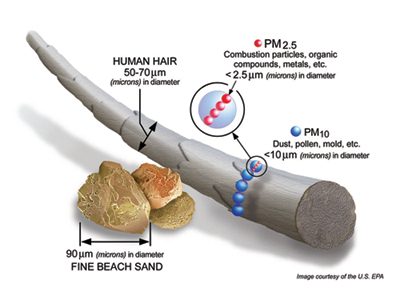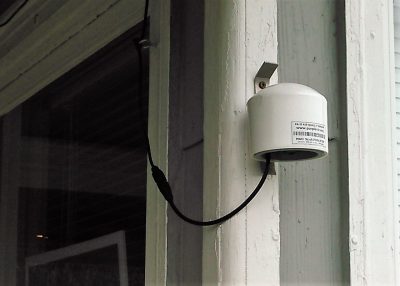Supporter Spotlight
This map of real-time air quality measurements in the Wilmington area may be zoomed out for a global view. Source: PurpleAir
WILMINGTON – Blue skies, white, marshmallow-like clouds and mild temperatures – the perfect day to train for that upcoming marathon, take the kids to a park, or walk a few brisk laps around the neighborhood.
Or, is it?
Residents in and around Wilmington now have access to a tool that takes them beyond the weather forecast to help determine if it’s a good day to be outdoors.

Charlotte-based Clean Air Carolina in recent months has had six portable fine-particle monitors installed throughout New Hanover County, giving residents access to real-time readings of particulate matter levels in the air.
Supporter Spotlight
That’s a major benefit to everyone, said Bob Parr, a retired emergency physician in Wilmington and a member of Clean Air Carolina’s Medical Advocates for Healthy Air advisory board.
“This is really exciting for me,” he said. “If people know their air quality then they can take simple steps to avoid bad air. They can look all over Wilmington and they can decide where they should go.”

Particulate matter, or PM, are tiny particles and liquid droplets that form in the atmosphere from various air pollution sources such as smokestacks, fires and automobiles.
There are two kinds of particulate matter, PM 2.5 and PM 10. PM 10 are inhalable particles that are generally 10 micrometers and smaller. PM 2.5 are fine, inhalable particles 2.5 micrometers and smaller.
These fine particles can be breathed deep into the lungs and, in some cases, enter the bloodstream, causing serious health problems.
It is these particles that are the focus of Clean Air Carolina’s initiative to place monitors in all of the state’s 100 counties.
The North Carolina Department of Environmental Quality’s Division of Air Quality has a little more than 20 ambient air monitors in 15 counties, including New Hanover County.The state’s ambient air monitors record several pollutants, including the ozone, PM 2.5 and PM 10, carbon monoxide, sulfur dioxide, nitrogen dioxide and lead.
The state reports its air monitor readings to the U.S. Environmental Protection Agency, or EPA.
“A lot of [the state’s monitors] are in urban areas,” said Calvin Cupini, Clean Air Carolina’s citizen science program manager. “They separate out into regions, but they leave a lot of open space in-between. For us, that’s just not enough information. To my knowledge we’re the only ones going at a state-level approach. Rather than a small study area, we’re going to have quite a large one.”
In New Hanover County, for example, the state’s monitor is in Castle Hayne, a relatively rural area of the county.
The PM readings at that site are much lower than those taken by the portable monitors dispersed in more urban areas of the county, including downtown Wilmington, Monkey Junction and Wrightsville Beach, Parr said.
“All of the six areas where we have them in Wilmington are measuring far in exceedance of the area of Castle Hayne,” he said. “I check it weekly at least. They never match what we’re finding.”
Within the last year and a half, Clean Air Carolina started delving into community-led research, applying for and receiving a grant to set up low-cost, portable monitors in Charlotte.

Each monitor is about the size of a clenched fist – small, white and looks like an upside-down coffee mug that can be perched in places such as porches, railings or on flagpoles.
Monitors are set up by volunteers at private homes, businesses or organizations at no cost. Installation, Cupini said, is simple, similar to setting up an Amazon Echo, taking about 10 minutes. A wireless Internet connection is required.
The monitors run 24 hours a day, seven days a week.
These monitors do not forecast the air quality. They may not be as sophisticated as the state’s ambient air monitors.
But, their value is that they give people an idea of what to expect before leaving their home for the day, Parr and Cupini said.
For someone with asthma, the information could help them determine whether they should make some adjustments to their day, like staying indoors or keeping an inhaler close by.
“Tiny little shifts will greatly impact your exposure,” Cupini said. “What we want to do is try to use these censors with an asthma cohort and we want to validate whether or not a stream of data in the palm of your hand will improve your respiratory health outcomes.”
Having this information at your fingertips is important for other at-risk populations, including the elderly, children and pregnant women, Parr said.
“I consider air pollution as second-hand smoke,” he said. “Someone else is producing the pollution and you’re stuck with breathing it. The nice thing about all this is we’re giving information to people that they may be able to avoid a preventable cause of health decline.”
For more information or to volunteer to set up a monitor in your county, visit cleanaircarolina.org/airkeepers







